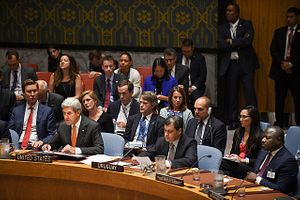North Korea conducted its fifth nuclear test on September 9. The test was seemingly Pyongyang’s largest ever, causing a 5.3 magnitude earthquake. The fourth nuclear test, carried out in January 2016, was also reported to have a seismic magnitude of 5.1. Although more powerful, the latest test cannot be described as a hydrogen bomb test; Pyongyang appears to have experimented with a boosted fission bomb, as in its fourth nuclear test.
A boosted fission bomb is an atomic bomb that uses a modest amount of fusion fuel (deuterium-tritium mixture) to increase the rate – and thus the destructive force – of nuclear fission. North Korea claimed that its fourth nuclear test (which probably involved a boosted fission bomb) was a hydrogen bomb test because it uses some fusion fuel. However, a hydrogen bomb is different from a boosted fission bomb because it derives its destructive force from the energy of the nuclear fusion itself, and a hydrogen bomb is far more powerful than a boosted fission bomb. Since North Korea is also not claiming that the latest test was a hydrogen bomb test, we are probably safe in assuming that Pyongyang was experimenting with a boosted fission bomb.
The “advantage” of a boosted fission bomb is that it can achieve a high yield even with a miniaturized nuclear warhead and be far more powerful and destructive than an atomic bomb. North Korea has already successfully conducted several test-firings of the Nodong missile (with a range of 1,200 km) and the extended-range (ER) Scud (with a range of 1,000 km), and it has the technology to land a missile in Japan’s exclusive economic zone. North Korea needs to miniaturize its nuclear warheads to mount them on these missiles, but the fact that it conducted a nuclear test so soon after its fourth suggests the possibility that Pyongyang tried out the same boosted fission bomb technology with a miniaturized warhead.
This interpretation is consistent with the fact that the expression “standardization” was used in the statement issued by North Korea after its fifth nuclear test. This term “standardization” is an expression of confidence that its nuclear warhead technology is stable and the same results can be obtained even when tests are repeated. It is also an assertion that these warheads can be mounted on missiles. Although there is actually no firm evidence that North Korea’s warheads can be mounted on the Nodong missile or any other missiles, there is also no evidence indicating that North Korea has failed to miniaturize its warheads. We should thus assume that Pyongyang is now able to mount warheads on its missiles.
There is also enormous significance in the fact that North Korea has stepped up the pace of its nuclear testing, conducting nuclear tests twice since the beginning of 2016, less than eight months apart, compared with a nuclear test once every few years previously. This not only suggests that North Korea has successfully standardized the technology but also that North Korea’s warhead manufacturing capability has increased significantly and Pyongyang will soon have the capability to mass produce nuclear warheads. Of course, North Korea needs plutonium and highly enriched uranium as fission fuel in order to mass produce warheads. However, North Korea is believed to have enough plutonium for 20 warheads already. What is more, a plant producing plutonium is known to have reopened at the beginning of this year, and experts believe that Pyongyang is capable of producing enough plutonium for two to four bombs a year.
North Korea’s miniaturization of its nuclear weapons and development of a system of mass production will significantly alter its military capability. Previously, as long as the nuclear warheads did not fit on the missiles, the threat was limited regardless of how many nuclear tests Pyongyang conducted. North Korea does not have strategic bombers, and even if it successfully test-fires submarine-launched ballistic missiles (SLBM), it does not have oceangoing nuclear submarines. Its only option for launching a nuclear attack was, therefore, to use vessels that were likely to be intercepted. However, if North Korea successfully miniaturizes warheads, making them small enough to fit on missiles, it will for the first time be capable of delivering nuclear weapons outside its own borders.
Moreover, if North Korea becomes capable of mass producing nuclear warheads, it will be able to mount the warheads on the 200 or so Nodong missiles it already has in its possession and fire multiple warheads simultaneously. This means that North Korea would be capable of launching a saturation attack, firing more missiles than Japan is able to intercept with the Standard Missile 3 (SM-3) mounted on Aegis destroyers, which are a core part of Japan’s ballistic missile defense system. In fact, North Korea fired three missiles that landed off the coast of Okushiri Island in September 2016. It succeeded in launching them almost simultaneously and they fell around the same spot. If North Korea’s aim is to break through Japan’s missile defense and attack the Japanese mainland, then North Korea definitely appears to be developing the capability to enable this.
In this case, the threat from North Korea is far greater than before and the time has come for Japan to change the way it deals with North Korea in the future. In other words, Japan has previously sought the denuclearization of the Korean Peninsular through pressure and dialogue. Moving forward it must not allow North Korea to use nuclear weapons and must reconstruct a deterrence strategy and negotiation strategy to ensure this. However, deterrence through military force may provoke the North Korean leadership into reckless behavior and so Japan’s approach needs to be carefully thought out. To this end, Japan needs to enlist China’s cooperation in imposing more effective sanctions and creating a framework to stop North Korea from using its nuclear weapons.
Kazuto Suzuki is a space policy expert and Professor of International Relations at Japan’s Hokkaido University.

































